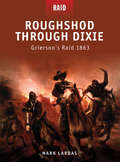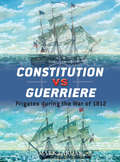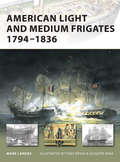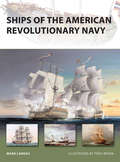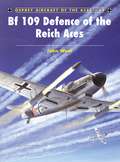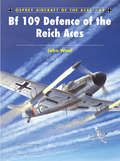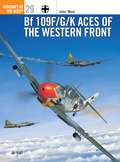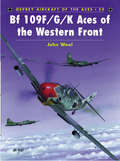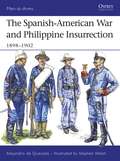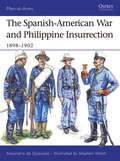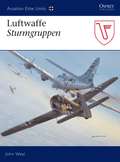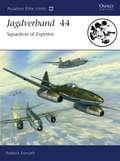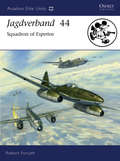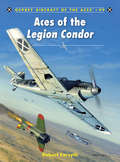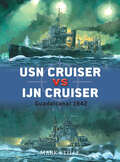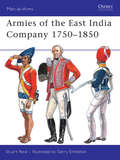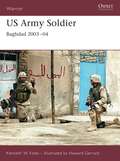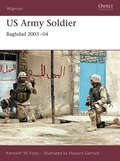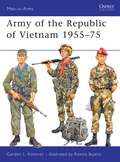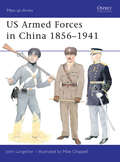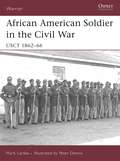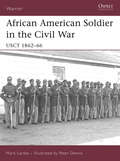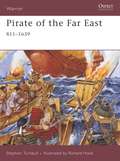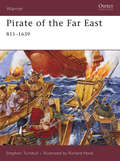- Table View
- List View
Roughshod Through Dixie: Grierson’s Raid 1863 (Raid)
by Johnny Shumate Mark Lardas Donato SpedaliereOn April 17, 1863 Benjamin Grierson led a force of 1,700 Union cavalrymen across enemy lines into Confederate-held Tennessee in a bold diversionary raid. Over the next seventeen days, Grierson's horsemen caused havoc by destroying railroad lines, attacking outposts, burning military stores and fighting numerous small actions, before breaking back through the lines at Baton Rouge. The raid was a tremendous success, not only by virtue of the destruction it caused, but also because the Confederates were forced to divert thousands of troops away from the front lines during General Grant's critical Vicksburg offensive. This book tells the complete story of one of the most daring Union raids of the war.
Constitution vs Guerriere: Frigates during the War of 1812 (Duel #19)
by Peter Bull Giuseppe Rava Mark LardasFamed as a classic naval duel, a one-on-one clash between two sailing frigates offered the victor immeasurable fame and glory. During the War of 1812, the Royal Navy and United States Navy squared off in four such duels, the most famous that between the USS Constitution and HMS Guerrière. Ships and tactics between the two nations varied enormously, with the American navy favouring a revolutionary design of frigate, with twenty-four pounder guns and heavy structural timbers, while the British, used to fighting the French and Spanish navies, relied on smaller, eighteen-pounder frigates. Through first-hand accounts of these four single-ship actions and fascinating comparisons of artillery, crew ability and tactical achievements, this book offers an unparalleled insight into the ruthless reality of frigate battles in the War of 1812.
American Light and Medium Frigates 1794–1836 (New Vanguard)
by Mark LardasThe 'Original Six' frigates were commissioned by the new-born US Navy at a staggering cost of nearly $700,000. Designed to be light and fast, these warships enabled America to project its power across the globe. Among the ships Mark Lardas examines is USS Constellation: the first ship to be commissioned by the United States Navy. Alongside stirring accounts of engagements during the Barbary Wars, the author explores the design and development of these frigates, explaining the shortcomings that led to their replacement by larger, heavier 44-gun models by 1800. Packed with contemporary illustrations of US frigates and their British and French rivals, this book follows the escalation of the naval 'arms race' during the 18th century.
Ships of the American Revolutionary Navy (New Vanguard #161)
by Mark LardasMark Lardas explores the origins of American warships, primarily light and medium frigates, built for the Continental Navy during the years 1776–1783. This was the first navy of the United States and much of the fleet was comprised of ships that had been modified from existing vessels, converted into warships to provide a crucial service during the American Revolutionary War. Despite having no real funding, this unique fleet had a surprising amount of success against the might of the Royal Navy, and this title discusses the strengths and weaknesses of each design, and the differences between European and American warships of the time. With a close look at how these ships performed in key battles, as well as the exploits of John Paul Jones – the founding father of the United States Navy – this is a complete, illustrated overview of the ships' service and development until France's entry into the war and the subsequent decline in importance of the Continental Navy.
Bf 109 Defence of the Reich Aces (Aircraft of the Aces)
by John WealThis volume tells the story of the daylight air battles over Germany through the eyes of the Bf 109 aces involved. It traces the development of the aerial defence of the Reich from its small beginnings to arguably the most savage and costliest campaign in the history of aerial warfare. The Luftwaffe pilots explain their tactics and relate their experiences – in the early days, waiting for short-ranged Allied fighters to turn back before attacking the bombers, the see-saw battle for aerial supremacy that followed, the advent of the P-51 and its devastating effect, the growing might of the heavy bomber streams and the final desperate measures against overwhelming odds. The story is predominantly that of the Bf 109's struggle to defeat the US Eighth Air Force, although latterly both the 'mediums' of the US Ninth Air Force and the 'heavies' of RAF Bomber Command were also active by day over Germany.
Bf 109 Defence of the Reich Aces (Aircraft of the Aces #68)
by John WealThis volume tells the story of the daylight air battles over Germany through the eyes of the Bf 109 aces involved. It traces the development of the aerial defence of the Reich from its small beginnings to arguably the most savage and costliest campaign in the history of aerial warfare. The Luftwaffe pilots explain their tactics and relate their experiences – in the early days, waiting for short-ranged Allied fighters to turn back before attacking the bombers, the see-saw battle for aerial supremacy that followed, the advent of the P-51 and its devastating effect, the growing might of the heavy bomber streams and the final desperate measures against overwhelming odds. The story is predominantly that of the Bf 109's struggle to defeat the US Eighth Air Force, although latterly both the 'mediums' of the US Ninth Air Force and the 'heavies' of RAF Bomber Command were also active by day over Germany.
Bf 109 F/G/K Aces of the Western Front (Aircraft of the Aces)
by John WealThe follow--on volume to Osprey Aircraft of the Aces 11 Bf 109D/E Aces 1939-41, this book charts the story of the myriad aces who flew the later marks of Messerschmitt fighter through to VE-Day. As good as the Emil had been during the opening 18 months of the war, the aircraft was being progressively bettered in virtually all aspects of aerial combat by the Spitfire come 1941, so Messerschmitt updated and improved the breed, firstly with the introduction of the Friedrich and then the multi-variant Gustav.
Bf 109 F/G/K Aces of the Western Front (Aircraft of the Aces #29)
by John WealThe follow--on volume to Osprey Aircraft of the Aces 11 Bf 109D/E Aces 1939-41, this book charts the story of the myriad aces who flew the later marks of Messerschmitt fighter through to VE-Day. As good as the Emil had been during the opening 18 months of the war, the aircraft was being progressively bettered in virtually all aspects of aerial combat by the Spitfire come 1941, so Messerschmitt updated and improved the breed, firstly with the introduction of the Friedrich and then the multi-variant Gustav.
The Spanish-American War and Philippine Insurrection: 1898–1902 (Men-at-Arms)
by Stephen Walsh Alejandro De QuesadaThis book details the uniforms and weapons of the American, Spanish, Cuban and Filipino forces involved in the United States Army's first overseas war. In 1898 the USA took the decision to intervene in the Cuban war of independence against Spain, and to expel the last vestige of European colonial rule from the Americas. This also led to the US acquiring rule over the Philippine Islands; and there, US troops were sent into the jungle to fight a "colonial†? war of their own, against Filipino insurgents unwilling to exchange one master for another. The text is illustrated with rare early photographs and color plates.
The Spanish-American War and Philippine Insurrection: 1898–1902 (Men-at-Arms #437)
by Stephen Walsh Alejandro De QuesadaThis book details the uniforms and weapons of the American, Spanish, Cuban and Filipino forces involved in the United States Army's first overseas war. In 1898 the USA took the decision to intervene in the Cuban war of independence against Spain, and to expel the last vestige of European colonial rule from the Americas. This also led to the US acquiring rule over the Philippine Islands; and there, US troops were sent into the jungle to fight a "colonial†? war of their own, against Filipino insurgents unwilling to exchange one master for another. The text is illustrated with rare early photographs and color plates.
Luftwaffe Sturmgruppen (Aviation Elite Units)
by John WealThe 'storm troopers' of the Luftwaffe, the elite Strumgruppen units comprised the most heavily armed and armoured fighter interceptors ever produced by the Germans. Their role was to smash like a mighty fist through the massed ranks of USAAF daylight bombers. Only volunteers could serve with these elite units, and each pilot was trained to close with the enemy and engage him in extremely short-range combat, attacking from the front and the rear in tight arrowhead formations. In exceptional circumstances pilots would even ram their enemy. This book chronicles the brief, but violent, career of the Sturmgruppen during the dark days of 1944-45, employing first-hand accounts and rare archival photography.
Luftwaffe Sturmgruppen (Aviation Elite Units #20)
by John WealThe 'storm troopers' of the Luftwaffe, the elite Strumgruppen units comprised the most heavily armed and armoured fighter interceptors ever produced by the Germans. Their role was to smash like a mighty fist through the massed ranks of USAAF daylight bombers. Only volunteers could serve with these elite units, and each pilot was trained to close with the enemy and engage him in extremely short-range combat, attacking from the front and the rear in tight arrowhead formations. In exceptional circumstances pilots would even ram their enemy. This book chronicles the brief, but violent, career of the Sturmgruppen during the dark days of 1944-45, employing first-hand accounts and rare archival photography.
Jagdverband 44: Squadron of Experten (Aviation Elite Units)
by Jim Laurier Robert ForsythThere was no Luftwaffe fighter unit like Jagdverband 44. Formed in February 1945, the unit grew out of Hitler's bizarre decision that the Me 262 jet fighter should be used as a bomber, despite its potential in the daylight defensive battles over the Reich. Seen as a grave mistake by Göring, a small fighter unit was formed in southern Germany to 'prove' the Me 262's ability as an interceptor. Formed with some of Germany's most experienced fighter pilots, Jagdverband 44 numbered a disproportionately high number of leading aces in its ranks, to the extent that it was said that the Knights' Cross was the unofficial badge of the unit. With numerous first-hand accounts from pilots and detailed colour profiles, this book is a fascinating account of the dramatic birth of the jet fighter and the impact it had during the bitter struggles of 1944-45.
Jagdverband 44: Squadron of Experten (Aviation Elite Units)
by Jim Laurier Robert ForsythThere was no Luftwaffe fighter unit like Jagdverband 44. Formed in February 1945, the unit grew out of Hitler's bizarre decision that the Me 262 jet fighter should be used as a bomber, despite its potential in the daylight defensive battles over the Reich. Seen as a grave mistake by Göring, a small fighter unit was formed in southern Germany to 'prove' the Me 262's ability as an interceptor. Formed with some of Germany's most experienced fighter pilots, Jagdverband 44 numbered a disproportionately high number of leading aces in its ranks, to the extent that it was said that the Knights' Cross was the unofficial badge of the unit. With numerous first-hand accounts from pilots and detailed colour profiles, this book is a fascinating account of the dramatic birth of the jet fighter and the impact it had during the bitter struggles of 1944-45.
Aces of the Legion Condor (Aircraft of the Aces #99)
by Jim Laurier Robert ForsythFor Germany, the Spanish Civil War proved a perfect testing ground for new technologies and tactics. During the war, some 19,000 German 'volunteers' formed an aviation group called the Legion Condor in support of the fascists. Originally flying He-51s, they were soon upgraded to 109s. These fighters proved dominant in the Spanish skies, and many members of the legion scored five or more kills during the fighting.
USN Cruiser vs IJN Cruiser: Guadalcanal 1942 (Duel #22)
by Mark StilleAlthough the war in the Pacific is usually considered a carrier war, it was the cruisers that dominated the early fighting. This thrilling duel presents the cruiser clashes during the battles for Guadacanal , highlighting the Battle of Savo Island and the Battle of Cape Esperance. The first was a Japanese victory that resulted in the loss of four Allied cruisers. However, in the latter, the Americans managed to turn the tables despite the battle being fought throughout the night. This book presents a view of the design and development of the opposing weapons systems, illustrated with newly commissioned digital artwork. It uses firsthand accounts to bring the battles to life and explain why the Americans suffered early on, but eventually had their revenge.
Armies of the East India Company 1750–1850 (Men-at-Arms #453)
by Gerry Embleton Stuart ReidContrary to popular belief, the capture of India was not accomplished by the British Army, but by the private armies of the East India Company, which grew in size to become larger than that of any European sovereign state. This is the history of its army, examining the many conflicts they fought, their equipment and training, with its regiments of horse, foot and guns, which rivalled those of most European powers. The development of their uniforms, which combined traditional Indian and British dress, is illustrated in detail in this colourful account of the private band of adventurers that successfully captured the jewel of the British Empire.
US Army Soldier: Baghdad 2003-04 (Warrior)
by Howard Gerrard Kenneth W EstesIn April 2003, after brief combat, Baghdad fell under US control and the Coalition Provisional Authority was formed to maintain order until a new Iraqi government became a reality. This book details the stabilization operations and the experiences of US Task Force 1st Armored Division (TF 1AD), whose soldiers lived and fought under extreme conditions and whose activities were center stage in the controversial debate surrounding the initial occupation of Iraq. Soldiers' personal experiences from recruitment, training, and armed combat to their aftermath and effects emerge from interviews and new documentation by author Kenneth W. Estes in his account of this crucial military campaign.
US Army Soldier: Baghdad 2003-04 (Warrior #113)
by Howard Gerrard Kenneth W EstesIn April 2003, after brief combat, Baghdad fell under US control and the Coalition Provisional Authority was formed to maintain order until a new Iraqi government became a reality. This book details the stabilization operations and the experiences of US Task Force 1st Armored Division (TF 1AD), whose soldiers lived and fought under extreme conditions and whose activities were center stage in the controversial debate surrounding the initial occupation of Iraq. Soldiers' personal experiences from recruitment, training, and armed combat to their aftermath and effects emerge from interviews and new documentation by author Kenneth W. Estes in his account of this crucial military campaign.
Army of the Republic of Vietnam 1955–75 (Men-at-arms Ser. #458)
by Ramiro Bujeiro Gordon L. RottmanEvolved from the colonial units created by the French, this book discusses the original reorganization of these forces into the first national army. Complete with a detailed history of the command structure and orders of battle, the author also sheds light on the little known divisional histories of the army through rare, original source material. Moreover, the author examines in detail the evolution of such key units as armoured forces, ranger commands as well as combat unit organisation. This together with a detailed analysis of the experiences of the typical rank and file soldier as well as officer corps provides a concise and detailed history of an army that is too often neglected or quickly judged.
US Armed Forces in China 1856–1941 (Men-at-Arms #455)
by Mike Chappell John LangellierThis volume reveals the little-known story of the 90-year presence of American forces in China until the fall of Peking in 1941. Included is coverage of the first operations on the Pearl River in 1856 as well as US involvement in the Boxer Rebellion of 1900. As China entered a chaotic period in her history, known as the years of the "Warlords†?, American marines also participated in numerous small-scale amphibious landings. Finally, during the later Sino-Japanese War and early into World War II, US volunteers of the "Flying Tigers†? became renowned for their combat missions in support of Chinese Nationalist forces, and their aerial duels are also recounted by the author John P. Langellier, who has spent several years researching the subject in the US and China. Discover the history of these various actions and the different services involved, recreated in color artwork and illustrated with rare, previously unpublished photographs.
African American Soldier in the Civil War: USCT 1862–66 (Warrior #114)
by Peter Dennis Mark LardasApproximately 200,000 African Americans fought for the Union during the Civil War. Initially, many white soldiers doubted their bravery and skill; they were soon proved wrong. The United States Colored Troops performed countless acts of courage, most famously at the battle of Fort Wagner where the 54th Massachusetts marched forth and scaled the parapets, only to be driven back in fierce hand-to-hand combat. Through fascinating first-hand accounts, this title examines the journey of the African American from slave to soldier to free man, ultimately providing a fascinating insight into the impact that these brave men had on the war and how it influenced their lives thereafter.
African American Soldier in the Civil War: USCT 1862–66 (Warrior #114)
by Peter Dennis Mark LardasApproximately 200,000 African Americans fought for the Union during the Civil War. Initially, many white soldiers doubted their bravery and skill; they were soon proved wrong. The United States Colored Troops performed countless acts of courage, most famously at the battle of Fort Wagner where the 54th Massachusetts marched forth and scaled the parapets, only to be driven back in fierce hand-to-hand combat. Through fascinating first-hand accounts, this title examines the journey of the African American from slave to soldier to free man, ultimately providing a fascinating insight into the impact that these brave men had on the war and how it influenced their lives thereafter.
Pirate of the Far East: 811-1639 (Warrior #125)
by Stephen Turnbull Richard HookFeared throughout the Far East, Japanese pirates were likened to 'black demons' and 'flood dragons'. For centuries relations between Japan, Korea and China were carried out through a bizarre trinity of war, trade and piracy. The piracy, which combined the other elements in a violent blend of free enterprise, is the subject of this original and exciting book. Stephen Turnbull vividly recreates the pirates' daily lives, from legitimate whaling and fishing trips to violent raids. He explores the bases and castles used by the pirates and uses eyewitness accounts and original artwork to give stunning descriptions of a vicious and brutal life.
Pirate of the Far East: 811-1639 (Warrior #125)
by Richard Hook Dr Stephen TurnbullFeared throughout the Far East, Japanese pirates were likened to 'black demons' and 'flood dragons'. For centuries relations between Japan, Korea and China were carried out through a bizarre trinity of war, trade and piracy. The piracy, which combined the other elements in a violent blend of free enterprise, is the subject of this original and exciting book. Stephen Turnbull vividly recreates the pirates' daily lives, from legitimate whaling and fishing trips to violent raids. He explores the bases and castles used by the pirates and uses eyewitness accounts and original artwork to give stunning descriptions of a vicious and brutal life.
